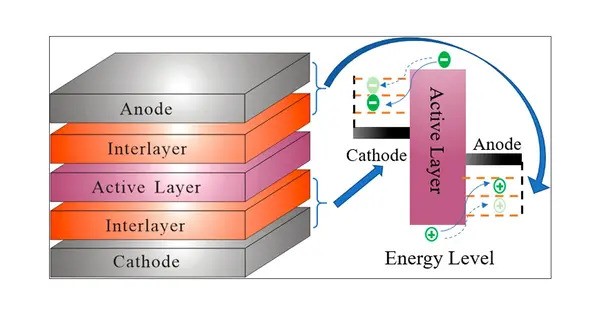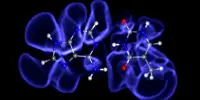New research from North Carolina State University provides a deeper understanding of precisely what is happening in organic solar cells as light is converted into electricity. Researchers developed a new method which visualizes interfaces where the sunlight’s energy is converted to electrical charges and used the findings to develop a set of design rules that can improve the efficiency of organic solar cells.
Organic solar cells are made with carbon-based polymer materials that have the potential to be low cost, can be made from earth-abundant materials, and have some attractive features — such as the fact that they can be made into semi-transparent or transparent window applications. In addition, as thin film solar cells they have the potential for lightweight and flexible solar applications amenable to roll-to-roll manufacturing — which could also make them easy to transport and install.
However, organic solar cells have not been as efficient as silicon or perovskite solar technologies at converting light into electricity.
“Organic solar cells are made of a mixture of two materials,” says Aram Amassian, co-corresponding author of a paper on the work and a university faculty scholar and professor of materials science and engineering at North Carolina State University.
“Both materials harvest electrons from sunlight. However, one of the materials is a polymer that harvests electrons, but then has to interact with the second material in order to pass those electrons on. The polymer is called a donor material; the other substance, typically a small molecule, is called the acceptor material. We knew that interfaces between donor and acceptor materials were responsible for a voltage loss — which is what currently limits the efficiency of organic solar cells. Our goal with this work was to gain a deeper understanding of what aspects of interfaces were responsible for the voltage loss so that we may improve them.”
Our study revealed that the functional interface in modern high performance organic solar cells, such as PM6:Y6, is the sharp donor-acceptor interface. The findings imply that this type of interface needs to be targeted to further reduce voltage losses.
Daniel Dougherty
To address this challenge, the researchers developed a scanning-probe microscopy method that allowed them to map not only the topographic characteristics of the donor and acceptor blend, but also the energy characteristics of the donor and acceptor materials at the interfaces — such as the energy gradient at the interface and how disordered the donor and acceptor materials are at the interface.
“This technique allowed us to determine how the degree of disorder of donor and acceptor molecules at the interface impacted the energy disorder,” says Daniel Dougherty, co-corresponding author of the paper and a professor of physics at NC State. “Once we had mapped the energetics of all of these interfaces, we were able to compare those findings with the results of conventional methods that characterize the overall performance of an organic solar cell’s voltage loss.”
The team needed to overcome another key challenge. As the scanning-probe microscopy technique does not directly measure voltage loss, the team could not tell which interface was the main culprit.
“Blends of donor and acceptor materials give rise to many different types of interfaces at once and it is not clear which interfaces are responsible for voltage losses,” Amassian says.
“Our study revealed that the functional interface in modern high performance organic solar cells, such as PM6:Y6, is the sharp donor-acceptor interface,” Dougherty says. “The findings imply that this type of interface needs to be targeted to further reduce voltage losses.”
“Once we identified the functional interface associated with voltage loss, we conducted a series of investigations into which factors influenced voltage loss,” Amassian says.
“There has been a longstanding debate in the organic solar cell community between people who argued that voltage loss was driven by energy differential between constituent donor and acceptor materials and people who argued that voltage loss was driven by energetic disorder along interfaces. Our experiments show that both sides are correct — it’s a combination of both factors.”
The researchers successfully demonstrated that it is possible to “fix” the energy differential and tune the disorder at interfaces by changing the way the donor and acceptor are blended during fabrication in such a way as to reduce the voltage loss as much as possible.
“By controlling for one of the drivers of voltage loss, we were actually able to identify engineering solutions that will help the organic solar cell community minimize the other driver of voltage loss,” Amassian says.
“Essentially, voltage losses are reduced by selecting a pair of materials with minimal energy offsets. Practitioners can then further reduce energy losses by identifying a solvent and processing parameters that substantially reduce interfacial disorder. We’re optimistic the design rules we developed using this technique can be used to inform organic solar cell research and development moving forward.”
















